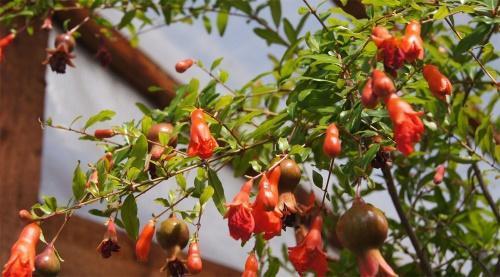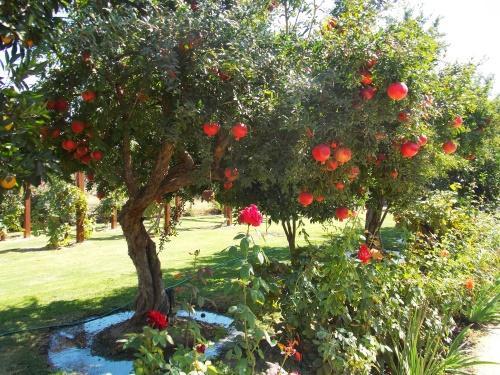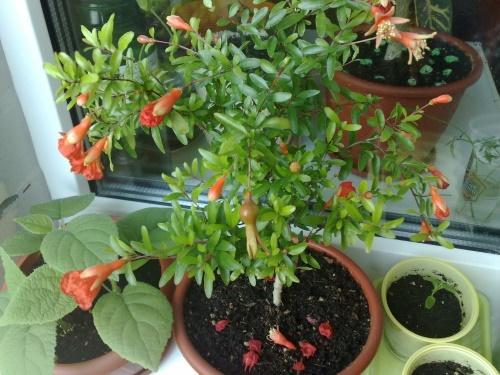How to grow pomegranate in the garden and in a pot on the window
 A pomegranate tree or bush will not only delight the owner with tasty and healthy fruits. It is also very beautiful, especially during flowering. In addition, the plant responds positively to shearing, which allows you to create beautifully shaped trees. Flexible twigs fit comfortably in any direction, and after pruning, they quickly grow new shoots. This makes pomegranate not only an ideal horticultural crop, but also a wonderful base for indoor bonsai. There is nothing particularly difficult in how to grow pomegranates. Given the place of his "residence" and providing the tree with the necessary care, in a couple of years you can see the first flowers and even enjoy juicy sweet and sour grains.
A pomegranate tree or bush will not only delight the owner with tasty and healthy fruits. It is also very beautiful, especially during flowering. In addition, the plant responds positively to shearing, which allows you to create beautifully shaped trees. Flexible twigs fit comfortably in any direction, and after pruning, they quickly grow new shoots. This makes pomegranate not only an ideal horticultural crop, but also a wonderful base for indoor bonsai. There is nothing particularly difficult in how to grow pomegranates. Given the place of his "residence" and providing the tree with the necessary care, in a couple of years you can see the first flowers and even enjoy juicy sweet and sour grains.
Features of growing garden pomegranate

It is necessary to plant pomegranates in a sunny area, where there are no drafts. At the same time, the soil should be nutritious and loose, and even better - crushed stone.
Garden pomegranate care is akin to other crops and includes:
- Watering as needed. You cannot fill a bush or tree, because its roots grow in the upper layer of the earth. Excess and stagnation of moisture will cause them to rot.
- Mulching the trunk circle. It will help to retain moisture and protect the pomegranate from drying out, which he also does not need.
- Seasonal feeding. In the spring, you need to give the plant an incentive for growth and fruiting by adding nitrogen-phosphorus preparations. In the summer, organic mullein feeding works well. In the fall, to prepare the crop for wintering, potassium-oriented fertilizers are used.
- Formation. Pruning can be done in early spring or after harvesting. Root shoots and thickening branches are cut out, clearing the middle of the crown. The best option is up to 5 strong branches per tree. Young twigs are also shortened in spring.
Separate attention should be paid to preparing a garden pomegranate for wintering. When the outside temperature drops to 10 ° C, the branches are tied, bent to the ground and fixed with staples. Top them sprinkle with soil or cover with burlap.
Before sheltering, pomegranates should be treated with Bordeaux mixture to protect against fungus.
How to grow a pomegranate in a pot?
 As a heat-loving culture, pomegranate does well indoors. In this case, it is often grown from seed. Indoor pomegranate - an excellent guest for southern windows, but in summer it requires shading. It is even better to take the pot out into the garden for the summer, but in the fall, be sure to take it back to the house.
As a heat-loving culture, pomegranate does well indoors. In this case, it is often grown from seed. Indoor pomegranate - an excellent guest for southern windows, but in summer it requires shading. It is even better to take the pot out into the garden for the summer, but in the fall, be sure to take it back to the house.
The pomegranate pot should not be deep - it blooms better in a tight container.
Watering during the growth period should be regular, but as the substrate dries out.With the onset of autumn, the frequency of watering is reduced, and after the foliage has fallen, it is completely reduced to a minimum. The pomegranate hibernates in the house, but in the cool, because from November to February it has a rest period. With the onset of spring, the pomegranate is returned to warmth, formative pruning is carried out and fed.